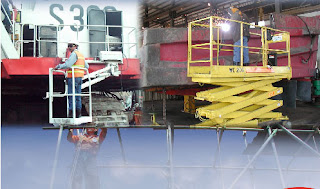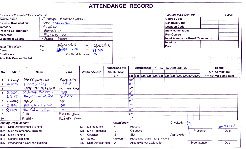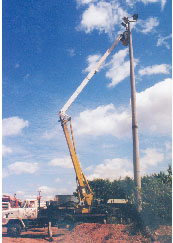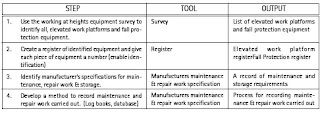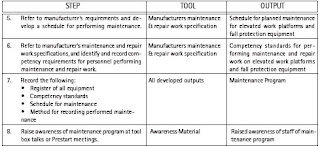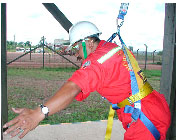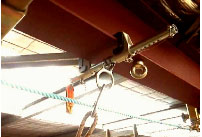Requirements and Specifications
Hazard Identification Risk Assessment and Control
A survey must be undertaken in order to identify all tasks where there is the potential to fall from a height greater than 1.8 meters. The survey must record:
• type of task being performed
• location of the task
• type of fall prevention or protection measures used
When performing the survey create a working team who have an understanding and knowledge of tasks performed by your work group at a height.
Performed Tasks
Identify working at height tasks include the following:
• major work carried out
• regularly performed jobs
• occasional jobs performed by your work group
• existing JSA records
• brainstorming with employees,
When you have exhausted all possibilities of tasks being performed at heights record them on the survey form.
To begin with it may be easier to list them alphabetically or group them according to jobs (for example; record vehicle maintenance tasks or jobs performed by an electrician at height etc).
Location of Task
Using the list of tasks, determine where you perform these tasks. Initially brainstorm where your team performs work. This will provide a list of locations for consideration. In some cases the same task maybe performed at different locations. Make sure you consider all options. Systematically work your way down the list of tasks.
Fall Prevention & Protection
Identify what fall prevention or protection equipment is used when performing the list of working at height tasks. Consider the following table when listing equipment.
Table 1 Fall Protection or Prevention Options
The completed survey will provide the basis for developing a register of all working at height tasks and working at height equipment which will be required to enable compliance to other parts of the code of practice. A Job Safety Analysis (JSA) must be conducted prior to any work being performed above a height of 1.8 meters and/or at any time the scope of work changes which may increase the risk of a fall.
Job Safety Analysis
All staff who are involved in working at heights must be are aware of the following two points
- a JSA needs to be completed prior to starting any working at height job
- when the job changes and it increases the risk of a fall you must check that the controls in place manage the increased risk
Ensure that a suitably trained person (supervisor or above) facilitates the JSA process and have the team participate in the development of the JSA. Remember to refer to your register of tasks and controls as you will already have stipulated what fall prevention or protection equipment you should be using. For every hazard identified you must have a plan to control the hazard. Keep the JSA on the job and refer to it when needed. Any task where the potential for falling cannot be eliminated using fall prevention measures then fall protection equipment must be provided.
Applying Control Measures
Fall prevention and protection measures are part of the hierarchy of controls. When managing any task refer to the hierarchy chart below and methodically work your way down. You will usually have to use a combination of the control methods to manage risks associated with working at height.
Selection, Training, Competency and Authorisation
Training and Competency
It is important to ensure all persons are:
• inducted to a level appropriate for the work they are doing at KPC
• aware of the relevant safety requirements at KPC workplaces
• appropriately trained so that their work is done safely
Divisions must ensure employees receive proper instruction and training. This is important and should take into account the functions of each employee, to provide them with the necessary skills and knowledge to enable them to do their work safely.
The type of instruction and training which can be provided include;
• Induction, which covers site instructions and policies
• On the job training,
• In house training program (HRDS) and
• Industry based or formal training (accredited or certificated courses)
All personnel conducting JSA’s for working at heights must:
• have completed basic working at heights awareness training
• be assessed as competent to perform the JSA
Job Safety Analysis for Working at Heights
Supervisors are the designated personnel to facilitate the development of a JSA with the team
The training and competency assessment system shall ensure:
• competency standards for personnel required to
• select, use, inspect and maintain fall protection equipment
• erect, inspect and dismantle scaffolding
• operate elevated work platforms, scissor lifts or man lifts
• perform maintenance on elevated work platforms i.e. scissor lifts, power steps, cherry
pickers
• training and competency assessments for the above personnel
• the recording of all training undertaken and results of competency assessments
• regular re-assessments of competencies and retraining when required
An overview of KPC working at heights safety requirements must be provided as part of the general induction program. Rescue personnel must be suitably trained in the emergency response requiring the recovery of personnel from a height.
Working at Heights Training
All personnel exposed to working at heights need to attend basic working at heights awareness training. Further training is then specific to the employee’s position and role. performing the work at heights. To ensure that the appropriate controls are used to manage the identified risks, personnel require a basic working at heights awareness to develop knowledge of the best control methods to use. Refer to Table 2 which outlines training requirements for working at heights.
The training and competency assessment system shall ensure:
• competency standards for personnel required to
• select, use, inspect and maintain fall protection equipment
• erect, inspect and dismantle scaffolding
• operate elevated work platforms, scissor lifts or man lifts
• perform maintenance on elevated work platforms i.e. scissor lifts, power steps, cherry pickers
• training and competency assessments for the above personnel
• the recording of all training undertaken and results of competency assessments
• regular re-assessments of competencies and retraining when required
An overview of KPC working at heights safety requirements must be provided as part of the general induction program. Rescue personnel must be suitably trained in the emergency response requiring the recovery of personnel from a height.
Working at Heights Training
All personnel exposed to working at heights need to attend basic working at heights awareness training.
Further training is then specific to the employee’s position and role.
Table 2 Working at Heights Training Matrix
Note: V Shaded box requires an appropriated kimper to perform the role.
Task Specific Training
Task specific training is for those personnel required to use or operate working at heights equipment. It is detailed training designed specifically for the type of equipment or task. In some instances prerequisite training is required prior to completing other training. For example to attend scaffolding training you must already have been deemed competent and current in Basic working at height awareness. It is the supervisor’s responsibility to ensure their training is current.
Training Register
Maintain a register of all staff who are trained in working at heights courses and the type of training they have received (course title & number). When a working at height job comes up, it is possible to refer to the register and know who is competent to perform the required tasks.
Communication and Awareness
Awareness information and/or instruction shall be provided periodically to personnel who perform work at heights and must include topics on:
• fall prevention and protection measures
• safety requirements for scaffolding, elevated work platforms and ladders
• emergency control requirements
• inspection and maintenance of fall protection equipment and anchor points
Awareness Information and Instruction
Information or instruction must be provided to personnel on a
regular basis, the purpose of this is to:
• review areas that maybe identified as high risk (this maybe site wide or specific to your work team),
• refresh information to personnel when a trend in reported incidents is identified
• maintain focus and heightened awareness of employees
Information should be provided in a form that all employees at the workplace can understand. Methods should be developed so that employees regardless of language or literacy levels can be provided with information. This can be accomplished using verbal (safety meetings, radio) or visual (posters, monthly banners, and short movies) methods.
It is recommended that the following topics regarding working at heights must be included in awareness information, for anyone exposed to working at heights over 1.8 meters:
• fall prevention and protection measures
• safety requirements for scaffolding, elevated work platforms and ladders
• emergency control requirements
• inspection and maintenance of fall protection equipment and anchor points
Develop a Schedule
Create a schedule to ensure the awareness information is presented regularly. Prestart talks or safety meetings (example below) are a good time to include the presentations as they already have a schedule and your team will be present.
Table 3 Awareness Presentations
By developing a schedule and keeping records of the presentations it is easy to monitor what has been presented, and pre-plan meetings. Where work at heights is being carried out, information must be provided on the hazards present and safety requirements. This may be achieved by:
• placing warning signs and barricades
• signage displaying fall protection requirements
• verbal methods (pre-start talks etc)
Communication of Hazards
Communicating hazards is an expansion of the administration level of the hierarchy of controls. This will usually be performed in conjunction with other controls. When communicating hazards ask the following: Who, What, Where, When and How
WHO – are you directing the information about the hazards to:
• employees involved in the task and/or
• people not involved in the task but who maybe affected
WHAT – are the hazard(s) or safety requirement(s) you need to communicate.
WHERE – does the information need to be communicated? This can be dependant on the type of method used. Signage might be useful well in advance, or a Prestart talk might be beneficial at the job so people understand what you are discussing and can understand the application.
WHEN – do you need to communicate this information?
Does it have to be ongoing, once off or repetitive?
HOW – decide on the best method of informing your target audience.
• Verbal (pre start talks, radio, meetings)
• Visual (signage, warning signs, posters, video)
• Physical (barrier, barricades, railing, guarding, cones)
Design, Purchase, Fabrication, Installation and Commissioning
Purchase specifications must be developed for all working at heights equipment including :
• fall prevention equipment
• fall protection equipment
Design specifications must be developed for working at heights equipment or controls including:
• fabricated work platforms
• fixed ladders
• man cages
• handrails on mobile equipment
Design & Purchase Specifications
Design and purchasing specifications are established to standardise equipment and ensure safe specifications are complied with. Refer to the register of working at height equipment for your area of responsibility and check that all equipment complies. When purchasing working at height equipment also ensure the design complies with the specifications. The Technical Specifications and Guidance for Use documents include the procurement specifications for the following equipment:
Fall Prevention
• fixed platform
• walkway
• stairway
• ladders – portable and fixed
• elevating work platform
• scaffolding
• moveable work platform
Fall Protection
• safety harnesses
• lanyards
• retractable reels – static lines
• anchorage points
A system shall be in place to ensure the commissioning of elevated work platforms prior to use at KPC.
Commissioning EWP
The commissioning program of an elevated work platform is managed by the KPC Competent Mechanical Engineer leading a team consisting of relevant parties. The user or custodian of the EWP shall submit at request for acquiring commissioning service to the following:
• Mining Services Division & Mining Operations Division: Engineer service section of Mining Services Division
• Processing and Infrastructure Division and other Divisions:
Mechanical engineering and design section of Processing and Infrastructure Division
For further detail on the commissioning process of EWP refer to the Technical Specification and Guidance for Use for Elevating Work Platforms.
Fall prevention equipment must consider: Kep/Men/555 – Decree of mines article 95.
For a copy of Kep/Men/555 – Decree of mines article 95 refer to appendix E.
Anchorage points must be fitted by a competent person to ensure that they are positioned appropriately and can take the required load.
Anchorage Points
Identify who is able to install an anchor point. This person will be required to certify the category for which the anchorage is suitable including the strength rating (15kN as a minimum for fall arrest) and the number of people who are permitted to be connected to the anchorage at any one time (max 2).
For further detail on anchorages refer to the KPC Technical Specification and Guidance for Use for Fall-restraint and Fall-arrest Systems
Work Method and Condition Control
Fall prevention measures must be the preferred method to control risk where work is performed above a height of 1.8 m, where this is not possible, fall protection measures must be applied.
Risk Control
Always consider the use of fall prevention measures prior to fall protection as fall prevention incorporates mechanical assistance and/or barriers which are designed to prevent falling whilst working at heights. These may include:
• elevated work platforms
• scaffolds
• fabricated work platforms
• ladders – portable and fixed
• man cages
Fall protection is a system designed to arrest a person falling, this does not prevent falls. These may include:
• safety harnesses
• lanyards
• retractable reels – static lines
• anchorage points
Operating Elevated Work Platforms
• Only persons with the appropriate KIMPER shall operate elevated work platforms.
• Only persons with the appropriate KIMPER shall erect, and dismantle scaffolding.
Ensure that only persons who are operating elevated work platforms have a current kimper.
Maintain a register of trained operators for elevated work platforms and only use those persons.
Always check that their kimper is current.
Include this requirement in the JSA as part of the controls.
Scaffolding Requirements
Personnel erecting scaffolding must be trained in the use of fall protection equipment. Maintain a register of trained persons to erect and dismantle scaffolding. Always check that their kimper is current. Include this requirement in the JSA as part of the hazard controls.
An identified hazard of erecting scaffolding is the increased opportunity for a fall due to the inherent risks involved. To ensure that all personnel who erect scaffolding have the skills to manage these diverse risks they must have completed training and be deemed competent in the use of fall protection.
Access to scaffolding shall be controlled by the use of the SCAFFTAG system. No work shall be performed on scaffolding unless the scaffold is displaying the ‘safe for use’ SCAFFTAG.
Access to Scaffolding (SCAFFTAG)
All scaffolding on site must be controlled by the SCAFFTAG system. It is the supervisor’s responsibility to make sure the scaffold is inspected and the SCAFFTAG remains current;
• prior to initial use
• weekly while erected
• prior to use after inclement weather
• whenever modifications are made to the scaffold
All personnel who are to perform work from a scaffold shall have completed the ‘Introduction to Working at Height’ training to understand how to use the SCAFFTAG system. Include the SCAFFTAG system in the awareness training program and remind staff during Prestart meetings.
Requirements for the use of Safety Harness equipment must include:
• the type of Safety Harnesses approved for use at KPC
• the situations in which it is to be used
• inspection by user prior to use
• the type of suitable anchor points to be used
Where safety harnesses are used, they must be attached to an anchor point at all times.
Safety Harnesses
All staff required to use safety harnesses should be identified in the working at heights training needs analysis. Staff must be trained as competent to inspect and correctly fit the safety harness. If this is not possible the supervisor is responsible to ensure that all harnesses have been inspected prior to use and staff are correctly fitted. Before starting your work, check you have the right harness for the job. There are three harnesses approved for use at KPC, all other harnesses must meet defined purchasing standards located in the Technical Specifications & Guidance for use for Fall Restraint and Fall Arrest Systems
Before starting a job, make sure there are suitable and enough anchor points available. The type of fallarrest system attached to an anchorage point shall be compatible with the anchorage strength indicated on any sign associate with the anchorage point. For further details on anchorages refer to the Technical Specification and Guidance for Use of Fallrestraint and Fall-arrest Systems
Maintenance
A maintenance program for all elevated work platforms must include:
- schedules for planned maintenance
- personnel trained and deemed competent to perform the maintenance
- maintenance and repair work undertaken in accordance with the manufacturer specifications and operational experience
- the use of manufacturers or approved compatible parts
- the recording of all maintenance and repair work conducted
Maintenance Program
A maintenance program for all working at height equipment ensures that equipment is fit for purpose when required. Repair and maintenance programs should specify:
• Where servicing is required
• What components require servicing
• The nature of the servicing required
• The frequency of servicing
• Who is responsible for maintaining repair and maintenance programs and
• How defects will be corrected
Steps to Implementing a Maintenance Program
Equipment Identifying Number
There must be a program to ensure that all Fall Protection equipment is:
• registered and numbered
• maintained and stored to manufacturers specifications
Each device used in fall restraint or fall arrest system shall be marked and registered with an identifying number. fall restraint and fall arrest devices number system shall be structured as in the following format.
Emergency Controls
A rescue plan for personnel using Fall Protection Equipment must be in place prior to any work being undertaken. Emergency Planning is necessary to prevent further loss or injury should an incident occur. Planning may involve simply providing first aid facilities and an emergency phone number, but it could also require specialist rescue equipment, training and exercises. Consideration shall be given during the planning the work (JSA) to include an emergency and rescue plan.
It must be remembered that a person suspended in a full body harness should be rescued as soon as possible after sustaining a fall before they begin to suffer suspension trauma which may have serious consequences. Therefore no one should work alone at heights in an isolated area particularly if they are using fall arrest equipment such as a harness and lanyard.
Emergency controls, procedures and rescue plan must be developed and implemented in consultation with employees. Adequate training must be given to employees in these procedures.
The plan should outline
• How to reach an injured person
• Any on site rescue equipment such as elevating work platforms working in the area
• Providing fall arrest systems and devices to effectively complete a rescue
• Ensuring employees are trained in emergency procedures and are familiar with fall arrest systems and devices
• The availability or access to first aid facilities or services, including trained first aiders
• The location, contact details and hours worked of additional support facilities, and;
• An effective and readily available means of communication
Monitoring, Inspections and Audits Inspection Program
Inspection of all fall prevention and fall protection equipment must include:
- schedules for conducting inspections
- requirements for inspections to be undertaken in accordance with manufacturer specifications and operational experience
- the recording of all inspections conducted
- inspections being carried out by a competent person
Fall prevention depends upon the continued efficiency and durability of fall arrest systems and devices. It is essential equipment is maintained correctly with inspections and correct examination at regular intervals, all inspections should be carried out by a competent person.
• Identify inspection requirements (manufacturers specifications and operational experience)
• Create checklist for each equipment
• Develop a plan for inspections
• Establish schedule (computer, record book, etc)
• Initiate the inspection as per the schedule
• Plan required inspections into the daily or weekly work schedule,
• Follow up to ensure it is completed by due date.
• Assign a competent person and appropriate resources to carry out the inspections.
• Perform the inspection using the approved checklist
• All results need to be recorded on the inspection checklist, including any non conformances.
• Any non conformances need to be included into the corrective action process.
• At the completion of the inspection close out the work order, or inspection register and up date records.
What to Inspect
Refer to working at heights equipment register, all items on the register will need to be inspected.
• Anchor points • Mobile work platforms and attachments
• Harness and accessories
• Scaffolds and access equipment
• Lanyards and accessories
• Work platforms and access equipment
• Static lines and accessories
• Stairs
• Rope systems and accessories
• Ladders
Inspection Checklist
An inspection checklist should be based on the manufacturer’s specifications and any site operation experience (frequency is generally no less than 6 months). The inspection checklists should include items such as:
• Physical damage
• Deterioration
• Wear
• Identification markings
• Corrosion/erosion
• Storage
• Metal fatigue
• Distortion and deformation
• Labelling (safety instructions)
• Statutory requirements
Inspection System
Check that the inspection system covers and maintains a record of the following:
• Specific equipment identification
• Repairs required and completed
• Persons authorised to conduct inspections
• Means of identifying the currency of the equipment
• Specific inspection checklists
• Required inspection time frames
• Completed inspections
• Persons authorised to carryout repairs
• Faults found
The Technical Specifications and guidance for use documents outline basic inspection requirements.
Scaffolding Inspections
Scaffolding and components must be inspected and recorded using the SCAFFTAG located on the scaffold:
• before erection
• prior to initial use
• weekly while erected
• prior to use after inclement weather
• whenever modifications are made to the scaffold
Anchorage Inspections
Anchorage points must be inspected by a competent person to ensure it can take the required load.
Anchorage points should be inspected to ensure the integrity of the anchor (shall be sound and firm). If the anchorage point is permanently fixed a sign shall be located at the anchorage point and will show the name of the installer and installation date, or if an existing structure has been certified, the name of the certifier and certification date. These anchorage points should be inspected at intervals not greater than 6 months.
If an anchorage point is to be used only for a period of less than one month and is therefore not labelled, it shall be removed as soon as it is no longer required. This type of anchorage point must be inspected by a competent person prior to use.
Where in the opinion of a competent person an anchorage is worn or the load bearing capacity of the anchorage may be impaired, the anchorage must not be used. While it is in that condition and while it is in that condition it shall be tagged to indicate that it is not to be used.
Only a licensed scaffolder should construct, inspect, modify, maintain and dismantle scaffolding.
Scaffolding and components must be inspected and recorded using the SCAFFTAG located on the scaffold:
• before erection
• prior to initial use
• weekly while erected
• prior to use after inclement weather
• whenever modifications are made to the scaffold
It is important that users of scaffolders understand how to use the SCAFFTAG system, and when to request an inspection.
Any repaired anchorages or anchorage systems that have been repaired are not to be used unless it has been inspected by a competent person who is of the opinion that the anchorage or system of anchorages can be used again.
Staff are expected to conduct an audit on safe work practices in work areas while encouraging employees to follow and if necessary improve those practices. The frequency that you are required to perform work at heights will influence the need to develop an observation schedule or a process for ensuring adhoc work at heights tasks are observed.
Reporting Assessment and Corrective Actions
Identifying Hazards or Defects
Hazards or defects identified with working at heights equipment must be reported, assessed, and must include:
• actions required to stand down or destroy unsafe equipment (safety harness, ladder or scaffolding)
• the recording of actions taken to correct the hazard or defect
• Fall protection equipment must be destroyed following a fall or where inspection has shown evidence of excessive wear or mechanical malfunction.
Hazards or defects maybe identified on working at heights equipment when performing inspections, carrying out maintenance or using equipment. With the understanding that hazards or defects can be identified at various times and locations a system needs to be developed which can ensure these can be reported and assessed accurately. Task observation on all work at heights activities must be undertaken to ensure requirements are being applied correctly:
• Planned Task Observations
• PRINASA
Reporting the hazard or defect
All persons are required to report any hazard or defect they find.
Appropriate methods for collecting defect information can be:
• hazard report
• maintenance report
• inspection checklist
If the defect renders the equipment unsafe, it must be appropriately isolated as soon as possible. If the full implications of the defect are unknown, then seek advice from your immediate supervisor. If the supervisor is advised of a defect, they should check that defect has been appropriately tagged and isolated, then decide on appropriate further action. Each type of working at heights equipment may have a different type of report. To identify any specific requirements refer to the specific technical specification and guidance documents.
Assessing and Action
The hazard or defect needs to be assessed by a competent person to decide if the equipment is to be stood down, destroyed or actions taken to correct the problem. A process will need to be developed for standing down or destroying equipment, some technical specification and guidance for use documents outline the basic requirements and maybe useful to start with. Australian Standards or the manufacturer may have recommendations for standing down or destroying equipment.
The process developed for standing down or destroying equipment must:
• Ensure the equipment is removed from register if destroyed
• Prevent the equipment from being used again
• Detail requirements for destroying equipment.
The process developed for correcting the problem must ensure:
• It is recorded in maintenance records
• Follows manufacturers or best practice requirements
• Is completed by a competent person
• Is certified for use by a competent person prior to being used again
